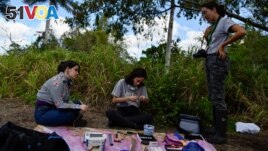23 February 2024
Researchers from Cuba are working with a Canadian partner to learn more about migratory birds that travel between North America and Cuba each year.
Daniela Ventura is a bird biologist at the University of Havana in Cuba. On a recent day, she caught a catbird with a net in the capital city's botanical gardens. The small, gray animal is one of the species of migratory birds that fly from the United States and Canada to Cuba each winter.
Ventura calls out observations to her students, who take notes nearby. She describes the species, its weight and its estimated body fat.

University of Havana professor Daniela Ventura speaks to students at Havana's Botanical Garden, in Havana, Cuba, February 9, 2024. (REUTERS/Norlys Perez)
The information provides new data for a joint project between Canada and Cuba. Ventura and the other project researchers hope to learn more about how and where the birds spend their winters in Cuba.
"We know a lot about their ecology in the breeding zone (in North America) but very little about what happens in their wintering zone," Ventura said.
Part of the problem is politics, said Lourdes Mugica. She is an expert on birds and helped organize the research.
A long-lasting U.S. embargo has made cooperation between the United States and Cuba difficult. That includes scientific research.
Migratory birds, of course, are indifferent to the restrictions.
"Birds don't understand embargoes or geographic borders, they don't need a visa to enter our country," Mugica said. "I hope there comes a time when relations are normal and that we can have joint projects between (the U.S. and Cuba.)"
Mugica says the project – with partnership from Environment and Climate Change Canada – suggests what is possible. Martin Acosta, another leading bird expert in Cuba, agrees.
The Canadian and Cuban partners put up a radio telemetry antenna in Cuba. The antenna operates as part of an international research network called MOTUS. It is the first time Cuba has been included in the MOTUS network.
The antenna can follow birds that have been radio-tagged in other parts of North America. It recently found in Cuba a small Swainson's thrush. The bird was first tagged in Canada's British Columbia – 5,000 kilometers away from the Caribbean nation.
"We never thought we'd reach the level of sophistication we now enjoy," said Acosta.
"Sophistication" means highly developed and complex.
Both Mugica and Acosta remember the hard days during their careers in science. Mugica said she lost over 30 kilograms doing research many years ago, at a time when food in Cuba was hard to find.
It is still hard to carry out their research some days, they say. Their 20-year-old truck needed a push start on a recent morning, for example.
But the teams celebrate small victories.
The catbird that Ventura recently captured had been given an identifying leg band back in November at the same place, data showed. The bird had gained body fat in the three months since, ahead of its migration north across the Gulf of Mexico.
Ventura said, "To think these little birds, which weigh less than 10 grams, cross the sea and come back and survive is spectacular."
I'm Gregory Stachel.
Dave Sherwood and Alien Fernandez reported this story for Reuters. Gregory Stachel adapted it for VOA Learning English.
_______________________________________________
Words in This Story
migrate – v. to move from one area to another at different times of the year
species – n. a group of animals or plants that are similar and can produce young animals or plants
ecology – n. a science that deals with the relationships between groups of living things and their environments
zone – n. an area that is different from other areas in a particular way
embargo – n. a government order that limits trade in some way
geography – n. an area of study that deals with the location of countries, cities, rivers, mountains, or lakes
antenna – n. a device (such as a wire or a metal rod) for sending or receiving radio or television signals
radio-tag – v. to attach a radio transmitter to (an animal)
spectacular – adj. causing wonder and admiration: very impressive